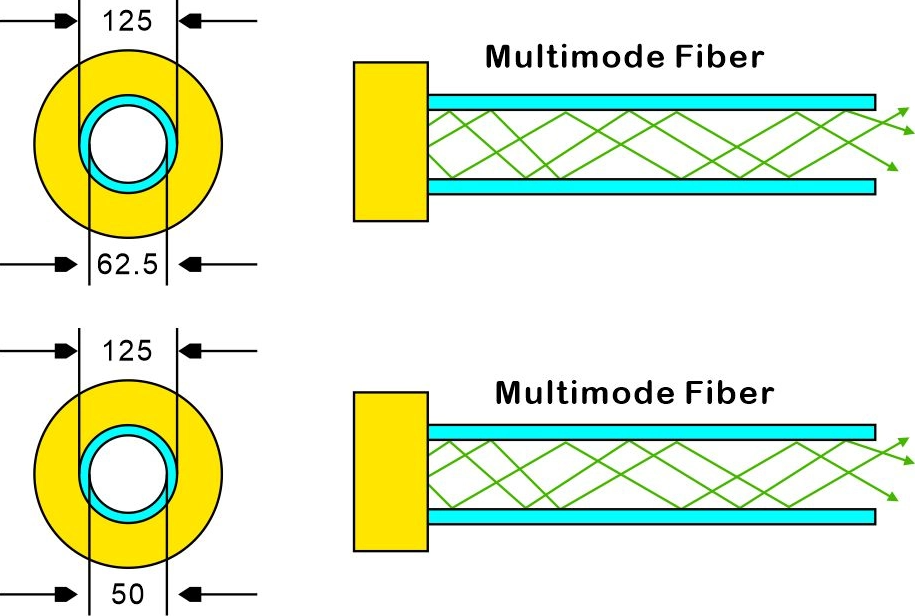

 Knowledge Base +
Knowledge Base +  2024.01.05
2024.01.05OS1 and OS2 are different types of optical fiber cables used for different purposes.
OS1 (Optical fiber, Single-mode) is designed for long-distance transmission. It has a smaller core and is used for applications that require larger bandwidth and longer transmission distances, such as telecommunications and long-distance networking.
OS2 (Optical fiber, Single-mode, 2nd generation) is also designed for long-distance transmission but has a lower attenuation and higher bandwidth compared to OS1. It is often used in higher speed transmissions over longer distances, such as in data centers and high-speed networking applications.
In summary, the main difference between OS1 and OS2 optical fiber cables lies in their attenuation, bandwidth, and application-specific purposes. OS2 is typically used for higher speed and longer distance transmissions compared to OS1.
Multimode fiber (MMF) is a kind of optical fiber mostly used in communication over short distances, for example, inside a building or for the campus. Multimode fiber optic cable has a larger core, typically 50 or 62.5 microns that enables multiple light modes to be propagated. Because of this, more data can pass through the multimode fiber core at a given time. The maximum transmission distance for MMF cable is around 550m at the speed of 10Git/s. It can transmit farther at lower data rates, such as going about 2km at 100Mb/s.

OM1:
For optical multimode fiber with 200/500MHz*km overfilled launch (OFL) bandwidth at 850/1300nm (typically 62.5/125um fiber which is now obsolete.)
OM2:
Type A1a.1 , for optical multimode fiber with 500/500MHz*km OFL bandwidth at 850/1300nm (typically 50/125um fiber)
OM3:
Type A1a.2, for laser-optimized 50um fiber having 2GHz*km effective modal bandwidth (EMB, also known as laser bandwidth), designed for 10 Gb/s transmission.
OM4:
Type A1a.3, for laser-optimized 50um fiber having 4.7GHz*km EMB bandwidth designed for 10Gb/s, 40 Gb/s, and 100 Gb/s transmission.
OM3 vs OM4
OM4 fiber has been on the market since 2005, sold as premium OM3 or OM3 fiber. The OM4 designation standardizes the nomenclature across all manufacturers so that the customer has a clearer
idea of the product that they are buying. OM4 is completely backwards compatible with OM3 fiber and shares the same distinctive aqua jacket. OM4 was developed specifically for VSCEL laser transmission
and allows 10 Gigabits/second link distances of up to 550 Meters (compared to 300 Meters with OM3). The effective modal bandwidth for OM4 is more than double that of OM3 (4700 MHz.km for OM4 vs 2000 MHz.km for OM3).
While OM3 fiber will still be future proof in most applications, allowing speeds of 10Gb/s up to 100Gb/s, OM4 fiber offers users longer length distances and more bandwidth for optical budgets.
OM5:
For laser-optimized for 50µm fiber greater than 28GHz*km EMB bandwidth designed for 40 Gb/s, and 100 Gb/s transmission.
Physical Difference
Physical difference mainly lies in diameter, jacket color, optical source and bandwidth, which is described in the following table.
MMF Cable Type | Diameter | Jacket Color | Optical Source | Bandwidth |
OM1 | 62.5/125µm | Orange | LED | 200MHz*km |
OM2 | 50/125µm | Orange | LED | 500MHz*km |
OM3 | 50/125µm | Aqua | VSCEL | 2000MHz*km |
OM4 | 50/125µm | Aqua | VSCEL | 4700MHz*km |
OM5 | 50/125µm | Lime Green | VSCEL | 28000MHz*km |
Practical Difference
Multimode fibers are able to transmit different distance ranges at various data rate. You can choose the most suited one according to your actual application. The max multimode fiber distance comparison at different data rate is specified below.
MMF Category | Fast Ethernet | 1GbE | 10GbE | 40GbE | 100GbE |
OM1 | 2000m | 275m | 33m | / | / |
OM2 | 2000m | 550m | 82m | / | / |
OM3 | 2000m | / | 300m | 100m | 70m |
OM4 | 2000m | / | 550m | 150m | 150m |
OM5 | / | / | 550m | 150m | 150m |
Subscribe to the newsletter
for all the latest updates.
2-5# Building, Tongfuyu Industrial Zone, Aiqun Road, Shiyan Street, Baoan District, Shenzhen. China
